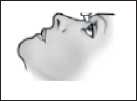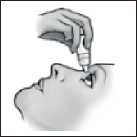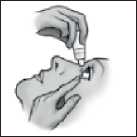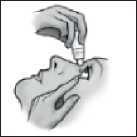Levofloxacin 5Mg/Ml Eye Drops Solution
Package leaflet: Information for the user
Levofloxacin 5mg/ml eye drops solution
Levofloxacin (as hemihydrate)
Read all of this leaflet carefully before you start taking this medicine because it contains important information for you.
- Keep this leaflet. You may need to read it again.
- If you have further questions, ask your doctor, pharmacist or nurse.
- This medicine has been prescribed for you only. Do not pass it on to others. It may harm them, even if their signs of illness are the same as yours.
- If you get any side effects, talk to your doctor, pharmacist or nurse. This includes any possible side effects not listed in this leaflet.
What is in this leaflet
1. What Levofloxacin eye drops are and what they are used for
2. What you need to know before you use Levofloxacin eye drops
3. How to use Levofloxacin eye drops
4. Possible side effects
5. How to store Levofloxacin eye drops
6. Contents of the pack and other information
1. What Levofloxacin eye drops solution is and what it is used for
One bottle of Levofloxacin 5mg/ml eye drops contains 5ml solution with levofloxacin as the active ingredient.
For the theoretical volume of one drop equivalent to 0.05ml the amount of drug substance is 0.256mg levofloxacin hemihydrate equivalent to 0.250mg of levofloxacin.
Levofloxacin is an antibiotic of the type called fluoroquinolones (sometimes shortened to quinolones). It works by killing some types of bacteria that can cause infections.
When levofloxacin is given in eye drops, it is used in children aged 1 year or over and in adults to treat bacterial infections that affect the front surfaces of the eye. One type of infection in this area is called bacterial conjunctivitis, which is an infection of the covering of the front of the eye (conjunctiva).
Levofloxacin eye drops is not suitable for treating eye infections that have spread in the deeper layers of the eye coverings or into the fluid within the eyeball. Antibiotic tablets or injections are needed to treat these deeper and more serious infections.
Levofloxacin eye drops is not recommended to be used in children aged below 1 year.
You must talk to a doctor if you do not feel better of if you feel worse after 5 days.
2. What you need to know before you use Levofloxacin eye drops solution
Do not use Levofloxacin eye drops solution:
- if you are allergic to levofloxacin, or other quinolones, or to any of the other ingredients of this medicine (listed in section 6).
- if you are not sure, ask your doctor or pharmacist first.
Warning and precautions
Talk to your doctor, pharmacist or nurse before taking Levofloxacin eye drops
- if an allergic reaction occurs, even after a single dose stop using the medicine
- if you observe worsening of your eye symptoms during treatment, please contact your doctor as soon as possible
- if you do not see any sign of recovery within a certain treatment period agreed with your doctor, please contact your doctor as soon as possible
- generally, no types of contact lenses should be worn when the eye is infected.
- Levofloxacin eye drops contains the preservative benzalkonium chloride, which may cause eye irritation.
As with all products containing the preservative benzalkonium chloride, soft contact lenses should not be worn whilst using this medicine because this can cause irritation of the eye coverings.
Children and adolescents
The special warnings and precautions for using this medicine are the same for adults, adolescents and children aged 1 year or over.
Other medicines and Levofloxacin eye drops solution
Tell your doctor or pharmacist if you are taking, have recently taken or might take any other medicines - even those not prescribed.
In particular, tell your doctor or pharmacist if you are applying any other type of eye drop or eye ointment before you start to use Levofloxacin eye drops.
If you are taking other eye drops, you should wait at least 15 minutes between applying Levofloxacin eye drops and any other type of eye drop.
Pregnancy, breast-feeding and fertility
If you are pregnant or breast-feeding, think you may be pregnant or are planning to have a baby, ask your doctor or pharmacist for advice before taking this medicine.
Levofloxacin eye drops should be used during pregnancy only if the potential benefit justifies the potential risk to the growing baby.
Although very small amounts of levofloxacin reach the blood and the breast milk, after instilling eye drops it is very unlikely that the eye drops will harm the growing baby.
Your doctor is informed about the potential risk and will advise you whether to take Levofloxacin eye drops in this case.
Your fertility (ability to become pregnant or to father a child) is not impaired when you apply Levofloxacin eye drops following its instructions for use.
Driving and using machines
Levofloxacin has minor influence on the ability to drive and use machines.
If the eye drops cause blurring of your sight when you use them, you should wait until this clears before driving or operating machinery.
3. How to use Levofloxacin eye drops solution
Always use this medicine exactly as your doctor or pharmacist has told you. Check with your doctor or pharmacist if you are not sure.
Levofloxacin eye drops are for ocular use and have to be applied to the outer surface of the eye. For patients above 1-year-old, the recommended dose is as follows:
DAYS 1 - 2
• Use one to two drops in the affected eye(s) every two hours.
• Use a maximum of 8 times per day.
DAYS 3 - 5
• Use one to two drops in the affected eye(s).
• Use a maximum of 4 times per day.
In elderly patients no adjustment of the usual dose is required.
The usual total treatment course is five days. Your doctor will advise you how long to apply the drops.
If you are putting any other medicine in your eye, you should wait at least 15 minutes between applying the different types of drops.
Use in children and adolescents
No dosage modification is required in children over 1-year-old and in adolescents.
Levofloxacin is not recommended to be used in children aged below 1 year.
Before applying the drops:
If possible, ask someone else to apply the drops for you. Ask them to read these instructions
with you before applying the drops.
1) Wash your hands
2) Open the bottle. Take special care that the tip of the dropper bottle does not touch your eye, the skin around your eye or your fingers. If this happens by accident you should tell your doctor or pharmacist so that you can obtain a clean bottle. Tilt your head backwards while seated, or lie down on your back.

3) Place the tip of the bottle close to your eye.

4) Pull the lower eyelid downwards and look up.

5) Press the bottle slightly and let one drop fall into the space between the lower eyelid and the eye.

6) Close your eye and press the inner corner of the eye with your finger for about one minute. Thus you can prevent the eye drop from draining down the tear duct.

7) Wipe off any excess solution from the skin around the eye.
If another drop is needed, and when both eyes are to be treated, repeat steps 3 to 6. Replace the cap securely after use.
Levofloxacin eye drops should not be injected into the interior part of the eyeball.
If you use more Levofloxacin eye drops solution than you should
If you use more Levofloxacin eye drops than you should, flush the eye(s) with water and tell your doctor or pharmacist.
If you forget to use Levofloxacin eye drops solution
If you forget to use the eye drops, put in the next dose as soon as you remember. Do not use a double dose to make up for a forgotten dose.
If you swallow Levofloxacin eye drops solution by accident:
The amount of levofloxacin in the provided bottle is too small to cause side effects.
However, if you are concerned, tell your doctor or pharmacist who will advise you on any necessary measures.
If you stop using Levofloxacin eye drops earlier than instructed, it may delay the healing process.
If you have any further questions on the use of this medicine or wish to stop your treatment, ask your doctor, pharmacist or nurse.
4. Possible side effects
Like all medicines, this medicine can cause side effects, although not everybody gets them. About one in ten people have a side effect when using Levofloxacin eye drops. Most of these affect only the eye and may not last very long. If you have any severe or persistent side effects you should stop using Levofloxacin eye drops and seek urgent advice from your doctor.
The frequency of possible side effects is defined as following:
|
very common |
affects more than 1 user in 10 |
|
common |
affects 1 to 10 users in 100 |
|
uncommon |
affects 1 to 10 users in 1,000 |
|
rare |
affects 1 to 10 users in 10,000 |
|
very rare |
affects less than 1 user in 10,000 |
|
not known |
frequency cannot be estimated from the available data |
Very rarely this medicine can cause severe allergic reactions.
The following symptoms can occur even after just one dose of Levofloxacin eye drops:
• Swelling and tightness in the throat
• Breathing difficulties
In rare cases other allergic reactions can develop. Symptoms of such reactions are:
• Worsening of redness and itching of the eyes
• Increased or sudden swelling of eyelids
Stop using Levofloxacin eye drops and contact a doctor immediately if any of these symptoms occur.
Common side effects (affect 1 to 10 users in 100):
• Burning feeling in the eye
• Decreased vision or mucus in the eye
Uncommon side effects (affect 1 to 10 users in 1,000):
• Stinging or irritation of the eyes
• Eye pain
• Dry or sore eyes
• Swelling or redness (bloodshot eyes) of the conjunctivae (front covering of the eye) or eyelid
• Abnormal intolerance to light
• Itchy eyes
• Sticky eyelids
• Headache
• Rash around the eye
• Stuffed or runny nose
Rare side effects (affect 1 to 10 users in 10,000)
• Allergic reactions such as skin rash
Very rare side effects (affect less than 1 user in 10,000)
• Swelling and tightness in the throat
• Breathing difficulty
Additional side effects in children and adolescents
Frequency, type and severity of side effects in children and adolescents are expected to be the same as in adults.
If you get any side effects, talk to your doctor or pharmacist. This includes any possible side effects not listed in this leaflet.
Reporting of side effects
If you get any side effects, talk to your doctor or pharmacist. This includes any possible side effects not listed in this leaflet. You can also report side effects directly via the Yellow Card Scheme (website: www.mhra.gov.uk/yellowcard). By reporting side effects you can help provide more information on the safety of this medicine.
5. How to store Levofloxacin eye drops solution
Keep this medicine out of the sight and reach of children.
Keep the bottle tightly closed.
Do not use this medicine after the expiry date which is stated on the bottle. The expiry date refers to the last day of that month.
Levofloxacin eye drops are to be used within 28 days after first opening the bottle.
Any remaining solution should be returned to your pharmacist for safe disposal.
To prevent infections, you must throw away the bottle 28 days after you first opened it, and use a new bottle.
Do not throw away any medicines via wastewater or household waste. Ask your pharmacist how to dispose of medicines no longer required. These measures will help protect the environment.
6. Contents of the pack and other information
What Levofloxacin eye drops solution contains
- The active substance is levofloxacin (as hemihydrate) 5 mg/ml.
- The other ingredients of Levofloxacin eye drops are:
Benzalkonium chloride, Sodium chloride, Sodium hydroxide or Hydrochloric acid for pH adjustment and Water for injections.
What Levofloxacin eye drops solution looks like and contents of the pack
Clear green yellowish aqueous solution
5ml of solution is supplied in a 5ml LDPE (low-density polyethylene) bottle with a LDPE dropper and a HDPE (high-density polyethylene) or HDPE/ LDPE cap.
Marketing Authorization Holder and Manufacturer
Marketing Authorization Holder
Aspire Pharma Ltd,
Unit 4, Rotherbrook Court
Bedford Road
Petersfield
Hampshire
GU32 3QG
United Kingdom
Manufacturer Rafarm S.A.
Thesi Pousi-Xatzi Agiou Louka,
Paiania Attiki 19002,
P.O.Box 37,
Greece